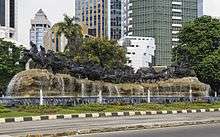Kurukshetra War
The Kurukshetra War, also called the Mahabharata War, is a war described in the Hindu epic poem Mahābhārata. The conflict arose from a dynastic succession struggle between two groups of cousins, the Kauravas and Pandavas, for the throne of Hastinapura. It involved several ancient kingdoms participating as allies of the rival groups.
| Kurukshetra War | |||||||
|---|---|---|---|---|---|---|---|
c. 1700 watercolour from Mewar depicts the Pandava and Kaurava armies arrayed against each other. | |||||||
| |||||||
| Belligerents | |||||||
| Other Allies |
| ||||||
| Commanders and leaders | |||||||
|
Overlord Yudhisthira Commanders-in-chief Dhrishtadyumna(day 1-18) † Divisonal-Commander Drupada † Virata † Abhimanyu † Satyaki Shikhandi Nakul Sahadeva Strategist Krishna |
Overlord Dhritrashtra Duryodhana † Commanders-in-chief Bhishma(day 1-10) † Drona(day 11-15) † Karna(day 16-17) † Shalya(day 18) † Ashwatthama(night raid) Other-Commanders Jayadratha † Kripa Kritavarma Bhurishravas † Bahlika † Bhagadatta † Sudakshina † Strategist Shakuni † | ||||||
| Strength | |||||||
|
7 Akshauhinis 153,090 chariots and chariot-riders 153,090 elephants and elephant-riders 459,270 horses and horse-riders 765,450 infantry (total 1,530,900 soldiers) |
11 Akshauhinis 240,570 chariots and chariot-riders 240,570 elephants and elephant-riders 721,710 horses and horse-riders 1,202,850 infantry (total 2,405,700 soldiers) | ||||||
| Casualties and losses | |||||||
|
Almost total(1,530,900 soldiers) only 8 known survivors - the five Pandavas, Krishna, Satyaki, Yuyutsu. |
Almost total(2,405,700 soldiers) only 4 known survivors - Ashwatthama, Sage Kripa, Kritavarma, Vrishakethu(son of Karna). | ||||||
The location of the battle is described as having occurred in Kurukshetra in North India. Despite only referring to these eighteen days, the war narrative forms more than a quarter of the book, suggesting its relative importance within the epic, which overall spans decades of the warring families. The narrative describes individual battles and deaths of various heroes of both sides, military formations, war diplomacy, meetings and discussions among the characters, and the weapons used. The chapters (parvas) dealing with the war (from chapter six to ten) are considered amongst the oldest in the entire Mahabharata.
The historicity of the war remains subject to scholarly discussions.[1] Attempts have been made to assign a historical date to the Kurukshetra War. Suggested dates range from 5561 to around 950 BCE, while popular tradition holds that the war marks the transition to Kaliyuga[2] and thus dates it to 3102 BCE. It is possible that the Battle of the Ten Kings, mentioned in the Rigveda, may have "formed the 'nucleus' of the story" of the Kurukshetra war, though it was greatly expanded and modified in the Mahabharata's account, which would, therefore, be of very dubious historicity.[3]
Background
Mahabharata, one of the most important Hindu epics, is an account of the life and deeds of several generations of a ruling dynasty called the Kuru clan. Central to the epic is an account of a war that took place between two rival families belonging to this clan. Kurukshetra (literally "field of the Kurus"), was the battleground on which this war, known as the Kurukshetra War, was fought. Kurukshetra was also known as "Dharmakshetra" (the "field of Dharma"), or field of righteousness. Mahabharata tells that this site was chosen because a sin committed on this land was forgiven on account of the sanctity of this land.. About 1.66 billions warriors death was described of war in the Indian epic.
The Kuru territories were divided into two and were ruled by Dhritarashtra (with his capital at Hastinapura) and Yudhishthira of the Pandavas (with his capital at Indraprastha). The immediate dispute between the Kauravas (sons of Dhritarashtra) and the Pandavas arose from a game of dice, which Duryodhana won by deceit, forcing his Pandava cousins to transfer their entire territories to the Kauravas (to Hastinapura) and to "go into exile" for thirteen years. The dispute escalated into a full-scale war when Duryodhana, driven by jealousy, refused to restore to the Pandavas their territories after the exile as earlier decided, because Duryodhana objected that they were discovered while in exile, and that no return of their kingdom had been agreed upon.
Historicity and dating
.png)
The historicity of the Kurukshetra War is subject to scholarly discussion and dispute.[6][7] The existing text of the Mahabharata went through many layers of development, and mostly belongs to the period between c. 500 BCE and 400 CE.[8][9][note 1] Within the frame story of the Mahabharata, the historical kings Parikshit and Janamejaya are featured significantly as scions of the Kuru clan,[11] and Michael Witzel concludes that the general setting of the epic has a historical precedent in Iron Age (Vedic) India, where the Kuru kingdom was the center of political power during roughly 1200 to 800 BCE.[11] According to Professor Alf Hiltebeitel, the Mahabharata is essentially mythological.[12] Indian historian Upinder Singh has written that:
Whether a bitter war between the Pandavas and the Kauravas ever happened cannot be proved or disproved. It is possible that there was a small-scale conflict, transformed into a gigantic epic war by bards and poets. Some historians and archaeologists have argued that this conflict may have occurred in about 1000 BCE.[7]
Despite the inconclusiveness of the data, attempts have been made to assign a historical date to the Kurukshetra War. Popular tradition holds that the war marks the transition to Kaliyuga and thus dates it to 3102 BCE. A number of other proposals have been put forward:
- P. V. Vartak calculates a date of 16 October 5561 BCE using planetary positions.
- P. V. Holey states a date of 13 November 3143 BCE using planetary positions and calendar systems.
- Aihole inscriptions give the date of Kurukshetra war around 3102 BCE.[13][2]
- K. Sadananda, based on translation work, states that the Kurukshetra War started on 22 November 3067 BCE.
- B. N. Achar used planetarium software to argue that the Mahabharata War took place in 3067 BCE.[14]
- S. Balakrishna concluded a date of 2559 BCE using consecutive lunar eclipses.
- R. N. Iyengar concluded a date of 1478 BCE using double eclipses and Saturn+Jupiter conjunctions.
- P. R. Sarkar estimates a date of 1298 BCE for the war of Kurukshetra.
- V. S. Dubey claims that the war happened near 950 BCE [15]
- Vedveer Arya gives the date of 3162 BCE, by distinguishing between Śaka & Śakanta Eras and applying correction of 60 years to the date given in Popular tradition and based on Aihole inspriction.[16]
Though the Kurukshetra War is not mentioned in Vedic literature, its prominence in later literature led British Indologist A. L. Basham, writing in 1954, to conclude that there was a great battle at Kurukshetra which, "magnified to titanic proportions, formed the basis of the story of the greatest of India's epics, the Mahabharata." Acknowledging that later "generations looked upon it as marking an end of an epoch," he suggested that rather than being a civil war it might have been "a muddled recollection of the conquest of the Kurus by a tribe of Mongol type from the hills." He saw it as useless to the historian and dates the war to the 9th century BCE based on archaeological evidence and "some evidence in the Brahmana literature itself to show that it cannot have been much earlier."[17][note 2]
According to Finnish Sindhologist Asko Parpola, the war may have taken place during the later phase of the Painted Grey Ware, circa 750-350 BCE.[19] Parpola also notes that the Pandava heroes are not being mentioned in the Vedic literature from before the Grhyasutras.[19] Parpola suggests that the Pandavas were Iranic migrants, who came to south Asia around 800 BCE.[20]
Puranic literature presents genealogical lists associated with the Mahabharata narrative. The evidence of the Puranas is of two kinds. Of the first kind, there is the direct statement that there were 1015 (or 1050) years between the birth of Parikshit (Arjun's grandson) and the accession of Mahapadma Nanda, commonly dated to 382 BCE, which would yield an estimate of about 1400 BCE for the Bharata battle.[21] However, this would imply improbably long reigns on average for the kings listed in the genealogies.[22]
Of the second kind are analyses of parallel genealogies in the Puranas between the times of Adhisimakrishna (Parikshit's great-grandson) and Mahapadma Nanda. Pargiter accordingly estimated 26 generations by averaging 10 different dynastic lists and assuming 18 years for the average duration of a reign, arrived at an estimate of 850 BCE for Adhisimakrishna and thus approximately 950 BCE for the Bharata battle.[23]
Indian archeologist B. B. Lal used the same approach with a more conservative assumption of the average reign to estimate a date of 836 BCE and correlated this with archaeological evidence from Painted Grey Ware sites, the association being strong between PGW artifacts and places mentioned in the epic.[24] John Keay confirm this and also gives 950 BCE for the Bharata battle.[25]
Style
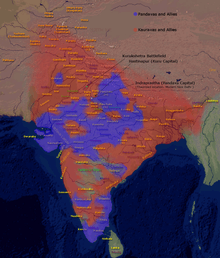
Jaya, the core of Mahabharata, is structured in the form of a dialogue between Kuru king Dhritarashtra (born blind) and Sanjaya, his advisor and chariot driver. Sanjaya narrates each incident of the Kurukshetra War, fought in 18 days, as and when it happened. Dhritarashtra sometimes asks questions, expresses doubts and sometimes laments, knowing about the destruction caused by the war to his sons, friends, and kinsmen. He also feels guilt for his own actions that led to this war, so destructive to the entire Indian subcontinent.
Some 18 chapters of Vyasa's Jaya comprise the Bhagavad Gita, one of the sacred texts of the Hindus. This work deals with diverse subjects like geography, history, warfare, religion and morality. According to the Mahabharata itself, the Jaya was recited to the King Janamejaya, the great-grandson of Arjuna, by Vaisampayana, a disciple of Vyasa (then called the Bharata). The recitation of Vaisampayana to Janamejaya was then recited again by a professional storyteller named Ugrasrava Sauti, many years later, to an assemblage of sages performing the 12-year-long sacrifice for King Saunaka Kulapati in the Naimisha forest (then called the Mahabharata).
Mahabharata account of the war
Beginning
In the beginning, Sanjaya gives a description of the various continents of the Earth, the other planets, and focuses on the Indian Subcontinent, then gives an elaborate list of hundreds of kingdoms, tribes, provinces, cities, towns, villages, rivers, mountains, forests, etc. of the (ancient) Indian Subcontinent (Bharata Varsha). He also explains the military formations adopted by each side on each day, the death of each hero and the details of each war-racing.
Krishna's Peace Mission
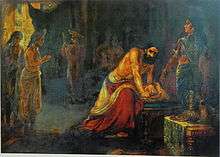
As a last attempt at peace is called for in Rajadharma, Krishna, the chieftain of the Yadavas, lord of the kingdom of Dwaraka, traveled to the kingdom of Hastinapur to persuade the Kauravas to see reason, avoid bloodshed of their kin, and to embark upon a peaceful path with him as the "Divine" ambassador of the Pandavas. Duryodhana was insulted that Krishna had turned down his invitation to accommodate himself in the royal palace. Determined to stop & hinder the peace mission & adamant of going to war with the Pandavas, Duryodhana plotted to arrest Krishna, and insult, humiliate, and defame him in front of the entire royal court of Hastinapura as a challenge to the prestige of the Pandavas and declaration of an act of open war.
At the formal presentation of the peace proposal by Krishna in the Kuru Mahasabha, at the court of Hastinapur, Krishna asked Duryodhana to return Indraprastha to the Pandavas and restore the status quo; or, if not, give over at least five villages, one for each of the Pandavas. Duryodhana said he would not give land even as much as the tip of a needle to the Pandavas. Krishna's peace proposals were ignored and dismissed, and Duryodhana publicly ordered his soldiers, even after the warnings from all the elders, to arrest Krishna. Krishna laughed and displayed his divine form, radiating intense light. Lord Krishna cursed Duryodhana that his downfall was certain at the hands of the one who was sworn to tear off his thigh, to the shock of the blind king, who tried to pacify the Lord with words as calm as he could find. His peace mission utterly insulted by Duryodhana, Krishna returned to the Pandava camp at Upaplavya to inform the Pandavas that the only course left to uphold the principles of virtue and righteousness was inevitable - war. During his return, Krishna met Karna, Kunti's firstborn (before Yudhishthira), and requested him to help his brothers and fight on the side of dharma. However, being helped by Duryodhana, Karna said to Krishna that he would battle against Pandavas as he had a debt to pay.
War preparations
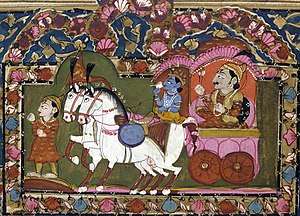
Duryodhana and Arjuna go to Krishna at Dwarka to ask for his help and that of his army. Duryodhana arrived first and found Krishna asleep. Being arrogant and viewing himself as equal to Krishna, Duryodhana chose a seat at Krishna's head and waited for him to rouse. Arjuna arrived later and being a humble devotee of Krishna, chose to sit and wait at Krishna's feet. When Krishna woke up, he saw Arjuna first and gave him the first right to make his request. Krishna told Arjuna and Duryodhana that he would give the Narayani Sena to one side and himself as a non-combatant to the other. Since Arjuna was given the first opportunity to choose, Duryodhana was worried that Arjuna would choose the mighty army of Krishna. When given the choice of either Krishna's army or Krishna himself on their side, Arjuna on behalf of the Pandavas chose Krishna, unarmed on his own, relieving Duryodhana, who thought Arjuna to be the greatest fool. Later Arjuna requested Krishna to be his charioteer and Krishna, being an intimate friend of Arjuna, agreed wholeheartedly and hence received the name Parthasarthy, or 'charioteer of the son of Pritha'. Both Duryodhana and Arjuna returned satisfied.
While camping at Upaplavya in the territory of Virata the Pandavas gathered their armies. Contingents arrived from all parts of the country and soon the Pandavas had a large force of seven divisions. The Kauravas managed to raise an even larger army of eleven divisions. Many kingdoms of ancient India such as Dwaraka, Kasi, Kekaya, Magadha, Chedi, Matsya, Pandya, and the Yadus of Mathura were allied with the Pandavas; while the allies of the Kauravas comprised the kings of Pragjyotisha, Kalinga, Anga, Kekaya, Sindhudesa, Avanti in Madhyadesa, Gandharas, Bahlikas, Mahishmati, Kambojas (with the Yavanas, Sakas, Trilinga, Tusharas) and many others.
Pandava Army

Seeing that there was now no hope for peace, Yudhishthira, the eldest of the Pandavas, asked his brothers to organize their army. The Pandavas accumulated seven Akshauhinis army with the help of their allies. Each of these divisions were led by Drupada, Virata, Abhimanyu, Shikhandi, Satyaki, Nakula and Sahadeva. After consulting his commanders, the Pandavas appointed Dhrishtadyumna as the supreme commander of the Pandava army. The Mahabharata says that kingdoms from all over ancient India supplied troops or provided logistic support on the Pandava side. Some of these were: Kekaya, Pandya (Malayadwaja Pandya),[26] Magadha, and many more.
Kaurava Army
The Kaurava army consisted of 11 Akshauhinis. Duryodhana requested Bhishma to command the Kaurava army. Bhishma accepted on the condition that, while he would fight the battle sincerely, he would not harm the five Pandava brothers. Also, Bhishma said that Karna would rather not fight under him, but serve as Duryodhana's bodyguard, as long as he was in the battlefield. Having little choice, Duryodhana agreed to Bhishma's conditions and made him the supreme commander of the Kaurava army, while Karna was debarred from fighting. But Karna entered the war later when Bhishma was severely wounded by Arjuna. Apart from the one hundred Kaurava brothers, headed by Duryodhana himself and his brother Dussasana, the Kauravas were assisted on the battlefield by Drona and his son Ashwatthama, the Kauravas' brother-in-law Jayadratha, the Brahmin Kripa, Kritavarma, Shalya, Sudakshina, Bhurishravas, Bahlika, Shakuni, Bhagadatta and many more who were bound by their loyalty towards either Hastinapura or Dhritarashtra.
Neutral parties
The kingdom of Bhojakata, with its King Rukmi, Vidura, the ex-prime minister of Hastinapur and younger brother to Dhritarashtra, and Balarama were the only neutrals in this war. Rukmi wanted to join the war, but Arjuna refused to allow him because he had lost to Krishna during Rukmini's swayamvar and yet he boasted about his war strength and army, whereas Duryodhana did not want Arjuna's reject. Vidura did not want to see the bloodshed of the war and was insulted extremely by Duryodhana, although he was the embodiment of Dharma himself and would have won the war for the Kauravas. The powerful Balarama refused to fight at Kurukshetra because he was both Bhima's and Duryodhana's coach in gadayudh (fighting with maces) and his brother Krishna is on the other side.
Army divisions and weaponry
The combined number of warriors and soldiers in both armies was approximately 3.94 million.[27] Each Akshauhini was under a commander or a general, apart from the commander-in-chief or the generalissimo who was the head of the entire army.
During the Kurukshetra War, various types of weapons were used by prominent warriors as well as ordinary soldiers. The weapons included: the bow, the mace, the sword, the lance and the dart. Almost all prominent warriors used bows, including the Pandavas, the Kauravas, Bhishma, Drona, Karna, Arjuna, Satyaki, Drupada, Jayadratha, Abhimanyu, Kripa, Kritavarma, Dhrishtadyumna and Shalya. However, many of them frequently used other weapons as well, for instance; the mace was used by Bhima, Duryodhana, Shalya, and Karna; the sword by Nakula, Satyaki, Jayadratha, Dhrishtadyumna, Karna and Kripa; and the lance by Karna, Yudhishthira, Shalya and Sahadeva.[28]
Rules of Engagement
The two supreme commanders met and framed "rules of ethical conduct", dharmayuddha, for the war. The rules included:[29]
- Fighting must begin no earlier than sunrise and end exactly at sunset.
- No more than one warrior may attack a single warrior.
- Two warriors may "duel", or engage in prolonged personal combat, only if they carry the same weapons and they are on the same type of mount (on foot, on a horse, on an elephant, or in a chariot).
- No warrior may kill or injure a warrior who has surrendered.
- One who surrenders becomes a prisoner of war and will then be subject to the protections of a prisoner of war.
- No warrior may kill or injure an unarmed warrior.
- No warrior may kill or injure an unconscious warrior.
- No warrior may kill or injure a person or animal not taking part in the war.
- No warrior may kill or injure a warrior whose back is turned away.
- No warrior may attack a woman.
- No warrior may strike an animal not considered a direct threat.
- The rules specific to each weapon must be followed. For example, it is prohibited to strike below the waist in mace warfare.
- Warriors may not engage in any unfair warfare.
Most of these rules were broken in the course of the war after the fall of Bhishma. For example, the second and sixth rules were violated on the 13th day, when Abhimanyu was slain.
Course of war
Before the Battle
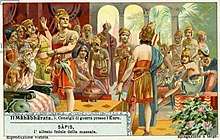
It was observed that the year in which the Mahabharata War took place, the year had three solar eclipses on earth in thirty days. Eclipses are considered ill for life on earth according to Hindu astrology.
On the first day of the war, as would be on all the following days, the Kaurava army stood facing west and the Pandava army stood facing east. The Kaurava army was formed such that it faced all sides: elephants formed its body; the kings, its head; and the steeds, its wings. Bhishma, in consultation with his commanders Drona, Bahlika and Kripa, remained in the rear.
The Pandava army was organised by Yudhishthira and Arjuna in the Vajra formation. Because the Pandava army was smaller than the Kaurava's, they decided to employ the tactic of each warrior engaging as many enemies as possible. This involved an element of surprise, with the bowmen showering arrows hiding behind the frontal attackers. The attackers in the front were equipped with short-range weapons like maces, battle-axes, swords, and lances.
Ten divisions (Akshauhinis) of the Kaurava army were arranged in a formidable phalanx. The eleventh was put under the immediate command of Bhishma, partly to protect him. The safety of the supreme commander Bhishma was central to Duryodhana's strategy, as he had placed all his hope on the great warrior's abilities. Dushasana, the younger brother of Duryodhana, was the military officer-in-charge of Bhishma's protection.
The Bhagavad Gita
When the war was declared and the two armies were facing each other, Arjuna realized that he would have to kill his dear granduncle (Bhishma), on whose lap he had played as a child and his respected teacher (Drona), who had held his hand and taught him how to hold the bow and arrow, making him the greatest archer in the world. Arjuna felt weak and sickened at the prospect of killing his entire family, including his 100 cousins and friends such as Ashwatthama. Despondent and confused about what is right and what is wrong, Arjuna turned to Krishna for divine advice and teachings. Krishna, who Arjuna chose as his charioteer, advised him of his duty. This conversation forms the Bhagavad Gita, one of the most respected religious and philosophical texts in the Hindu religion. Krishna instructs Arjuna not to yield to degrading impotence and to fight his kin, for that was the only way to righteousness. He also reminded him that this was a war between righteousness and unrighteousness (dharma and adharma) and it was Arjuna's duty to slay anyone who supported the cause of unrighteousness, or sin. Krishna then revealed his divine form and explained that he is born on earth in each eon when evil raises its head. It also forms one of the foremost treatises on the several aspects of Yoga and mystical knowledge.
Before the battle began, Yudhishthira did something unexpected. He suddenly dropped his weapons, took off his armor, and started walking towards the Kaurava army with folded hands in prayer. The Pandava brothers and the Kauravas looked on in disbelief, thinking Yudhishthira was surrendering before the first arrow was shot. Yudhishthira's purpose became clear, however, when he fell on Bhishma's feet to seek his blessing for success in battle. Bhishma, the grandfather to both the Pandavas and Kauravas, blessed Yudhishthira. Yudhishthira returned to his chariot and the battle was ready to commence.
Day 1
When the battle was commenced, Arjuna created a Vajra formation and Bhishma went through the Pandava formation wreaking havoc wherever he went, but Abhimanyu, Arjuna's son, seeing this went straight at Bhishma, defeated his bodyguards and directly attacked the commander of the Kaurava forces. However, the young warrior couldn't match the prowess of Bhishma and was defeated. The Pandavas suffered heavy losses and were defeated at the end of the first day. Virata's sons, Uttara and Sweta, were slain by Shalya and Bhishma. Krishna consoled the distraught Yudhishthira saying that eventually, victory would be his.
Day 2
The second day of the war commenced with a confident Kaurava army facing the Pandavas. Arjuna, realizing that something needed to be done quickly to reverse the Pandava losses, decided that he had to try to kill Bhishma. Krishna skillfully located Bhishma's chariot and steered Arjuna toward him. Arjuna tried to engage Bhishma in a duel, but the Kaurava soldiers placed a cordon around Bhishma to protect him and attacked Arjuna to try to prevent him from directly engaging Bhishma. Arjuna and Bhishma fought a fierce battle that raged for hours. Drona and Dhrishtadyumna similarly engaged in a duel in which Drona defeated Dhrishtadyumna. Bhima intervened and rescued Dhrishtadyumna. Duryodhana sent the troops of Kalinga to attack Bhima and most of them, including the king of Kalinga, lost their lives at his hands. Bhishma immediately came to relieve the battered Kalinga forces. Satyaki, who was assisting Bhima, shot at Bhishma's charioteer and killed him. Bhishma's horses, with no one to control them, bolted carrying Bhishma away from the battlefield. The Kaurava army had suffered great losses at the end of the second day and was considered defeated.
Day 3
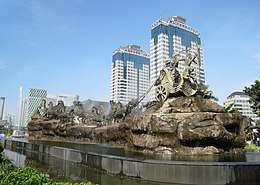
On the third day, Bhishma arranged the Kaurava forces in the formation of an eagle with himself leading from the front, while Duryodhana's forces protected the rear. Bhishma wanted to be sure of avoiding any mishap. The Pandavas countered this by using the crescent formation with Bhima and Arjuna at the head of the right and the left horns, respectively. The Kauravas concentrated their attack on Arjuna's position. Arjuna's chariot was soon covered with arrows and javelins. Arjuna, with amazing skill, built a fortification around his chariot with an unending stream of arrows from his bow. Abhimanyu and Satyaki combined to defeat the Gandhara forces of Shakuni. Bhima and his son Ghatotkacha attacked Duryodhana in the rear. Bhima's arrows hit Duryodhana, who swooned in his chariot. His charioteer immediately drove them out of danger. Duryodhana's forces, however, saw their leader fleeing the battlefield and soon scattered. Bhishma soon restored order and Duryodhana returned to lead the army. He was angry at Bhishma, however, at what he saw as leniency towards the five Pandava brothers and spoke harshly at his commander. Bhishma, stung by this unfair charge, fell on the Pandava army with renewed vigor. It was as if there were more than one Bhishma on the field.
Arjuna attacked Bhishma trying to restore order. Arjuna and Bhishma again engaged in a fierce duel, however, Arjuna's heart was not in the battle as he did not like the idea of attacking his grand-uncle. During the battle, Bhishma killed numerous soldiers of Arjuna's armies.
Day 4
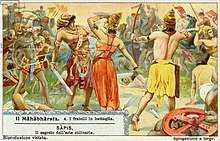
The fourth day of the battle was noted for the valor shown by Bhima. Bhishma commanded the Kaurava army to move on the offensive from the outset. While Abhimanyu was still in his mother's womb, Arjuna had taught Abhimanyu on how to break the chakra vyuha. But, before explaining how to exit the chakra Vyuha, Arjuna was interrupted by Krishna (another story is that Abhimanyu's mother falls asleep while Arjuna was explaining the chakra vyuha exit strategy). Thus from birth, Abhimanyu only knew how to enter the Chakra vyuha but didn't know how to come out of it. When the Kauravas formed the chakravyuha, Abhimanyu entered it but was surrounded and attacked by many Kaurava princes. Arjuna joined the fray in aid of Abhimanyu. Bhima appeared on the scene with his mace aloft and started attacking the Kauravas. Duryodhana sent a huge force of elephants at Bhima. When Bhima saw the mass of elephants approaching, he got down from his chariot and attacked them singlehandedly with his iron mace. They scattered and stampeded into the Kaurava forces killing many. Duryodhana ordered an all-out attack on Bhima. Bhima withstood all that was thrown at him and attacked Duryodhana's brothers, killing eight of them. Bhima was soon struck by an arrow from Dushasana, the second-eldest Kaurava, on the chest and sat down in his chariot dazed.
Duryodhana was distraught at the loss of his brothers. Overwhelmed by sorrow, he went to Bhishma at the end of the fourth day of the battle and asked his commander how could the Pandavas, facing a superior force against them, still prevail and win. Arjuna used the Aindra-Astra which killed thousands of Rathis, Atirathis, Elephants, and horses.
Bhishma replied that the Pandavas had justice on their side and advised Duryodhana to seek peace.
Day 5
When the battle resumed on the fifth day, the slaughter continued. The Pandava army again suffered from Bhishma's attacks. Satyaki bore the brunt of Drona's attacks and could not withstand them. Bhima drove by and rescued Satyaki. Arjuna fought and killed thousands of soldiers sent by Duryodhana to attack him. Bhima engaged in a fierce duel with Bhishma, which remained inconclusive. Drupada and his son Shikandi drove to aid Bhima in his fight against Bhishma, but they were stopped by Vikarna, one of Duryodhana's brothers, who attacked them with his arrows, injuring both father and son badly. The unimaginable carnage continued during the ensuing days of the battle.
Day 6
The sixth day was marked by a prodigious slaughter. Drona caused an immeasurable loss of life on the Pandava side. The formations of both the armies were broken. However, Bhima managed to penetrate the Kaurava formation and attack Duryodhana. Duryodhana was defeated but was rescued by others. The Upapandavas (sons of Draupadi) fought with Ashwathama and destroyed his chariot. The day's battle ended with the defeat of the Kauravas.
Day 7
On the seventh day, Drona slew Shanka, a son of Virata. Yuyuthsu was injured by Kripacharya in a sword fight. Nakula and Sahadeva fight Duryodhana's brothers but are overwhelmed by the number of them. The terrific carnage continued, and the day's battle ended with the victory of the Kauravas.
Day 8
On the eighth day, Bhima killed 17 of Dhritarashtra's sons. Iravan, the son of Arjuna, and the snake-princess Ulupi killed five brothers of Shakuni, princes hailing from Gandhara. Duryodhana sent the Rakshasa fighter Alamvusha to kill Iravan, and the latter was killed by the Rakshasa after a fierce fight. The day ended with a crushing defeat of the Kauravas.
Day 9
On the ninth day, Bhishma began destroying Pandava armies. Arjuna headed to Bhishma but Arjuna was not fighting with full power since he didn't wan't to hurt his beloved grandsire Bhishma. Krishna, overwhelmed by anger at the apparent inability of Arjuna to kill Bhishma, rushed towards the Kaurava commander, jumping furiously from the chariot taking the wheel of a fallen chariot in his hands. According to some texts, Bhishma, however, tried to attack Krishna with his arrows when the entire cosmos comes to rest and the time arrives for Bhishma as instructed by his mother Ganga to learn the actual dharma when Krishna reveals himself as the "Supreme Parabrahman" after which Bhishma laid down his arms and stood ready to die at the hands of the Lord, but Arjuna stopped him, reminding of his promise not to wield a weapon. On the other hand, the Upapandavas and Abhimanyu combatted the demons and their king Alambusha.
Realizing that the war could not be won as long as Bhishma was standing, Krishna suggested the strategy of placing a eunuch in the field to face him. Some sources however state that it was Yudhishthira who visited Bhishma's camp at night asking him for help. To this Bhishma said that he would not fight a eunuch.
Day 10
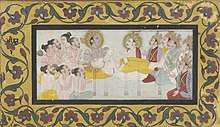
On the tenth day, the Pandavas, unable to withstand Bhishma's prowess, decided to put Shikhandi, who had been a woman in a prior life, in front of Bhishma, as Bhishma has taken a vow not to attack a woman. Shikhandi's arrows fell on Bhishma without hindrance. Arjuna positioned himself behind Shikhandi, protecting himself from Bhishma's attack and aimed his arrows at the weak points in Bhishma's armor. Soon, with arrows sticking from every part of his body, the great warrior fell from his chariot. His body did not touch the ground as it was held aloft by the arrows protruding from his body.
The Kauravas and Pandavas gathered around Bhishma and at his request, Arjuna placed three arrows under Bhishma's head to support it. Bhishma had promised his father, King Shantanu, that he would live until Hastinapur was secured from all directions. To keep this promise, Bhishma used the boon of "Ichcha Mrityu" (self-wished death) given to him by his father. After the war was over, when Hastinapur had become safe from all sides and after giving lessons on politics and Vishnu Sahasranama to the Pandavas, Bhishma died on the first day of Uttarayana.
Day 11
With Bhishma unable to continue, Karna entered the battlefield, much to Duryodhana's joy. He made Drona the supreme commander of the Kaurava forces, according to Karna's suggestion. Duryodhana wanted to capture Yudhishthira alive. Killing Yudhishthira in battle would only enrage the Pandavas more, whereas holding him as hostage would be strategically useful. Drona formulated his battle plans for the eleventh day to this aim. He cut down Yudhishthira's bow and the Pandava army feared that their leader would be taken, prisoner. Arjuna rushed to the scene, however, and with a flood of arrows stopped Drona.
Day 12
With his attempts to capture Yudhishthira thwarted, Drona confided to Duryodhana that it would be difficult as long as Arjuna was around. So, he ordered the Samsaptakas (the Trigarta warriors headed by Susharma, who had vowed to either conquer or die) to keep Arjuna busy in a remote part of the battlefield, an order which they readily obeyed, on account of their old hostilities with the Pandava scion. However, Arjuna managed to defeat them before the afternoon, and then faced Bhagadatta, the ruler of Pragjyotisha kingdom (modern-day Assam, India), who had been creating havoc among the Pandava troops, defeating great warriors like Bhima, Abhimanyu and Satyaki. Bhagadatta fought with Arjuna riding on his gigantic elephant named Supratika. Arjuna and Bhagadatta fought a fierce duel, and finally Arjuna succeeded in defeating and killing his antagonist. Drona continued his attempts to capture Yudhishthira, however his attacks were repelled by Prativindhya that day. The Pandavas, however, fought hard and delivered severe blows to the Kaurava army, frustrating Drona's plans.
Day 13
On the 13th day, Drona arrayed his troops in the Chakra/Padma/Kamala formation, a very complex and almost impenetrable formation. His target remained the same, that is, to capture Yudhishthira. Among the Pandavas, only Arjuna and Krishna knew how to penetrate this formation, and to prevent them from doing so, the Samsaptakas led by Susharma again challenged Arjuna and kept him busy at a remote part of the battlefield the whole day. Arjuna killed thousands of Samsaptakasa, however, he couldn't exterminate all of them.
On the other side of the battlefield, the remaining four Pandavas and their allies were finding it impossible to break Drona's Chakra formation. Yudhishthira instructed, Abhimanyu, the son of Arjuna and Subhadra, to break the Chakra/Padma formation. Abhimanyu knew the strategy of entering the Chakra formation, but did not know how to exit it so the Pandava heroes followed him to protect him from any potential danger. As soon as Abhimanyu entered the formation, however, King Jayadratha stopped the Pandava warriors. He held at bay the whole Pandava army, thanks to a boon obtained from Lord Shiva, and defeated Bhima and Satyaki.
Inside the Chakra/Kamala formation, Abhimanyu slew tens of thousands of warriors. Some of them included Vrihadvala (the ruler of Kosala), the ruler of Asmaka, Martikavata (the son of Kritavarma), Rukmaratha (the son of Shalya), Shalya's younger brother, Lakshmana (the son of Duryodhana) and many others. He also managed to defeat great warriors like Drona, Ashwatthama, Kritavarma, Karna, Duryodhana, Shakuni and others.
Facing the prospect of the complete annihilation of their army, the Kaurava commanders devised a strategy to deter Abhimanyu from causing further damage to their force. According to Drona's instructions, six warriors together attacked Abhimanyu (the warriors included Drona himself, Karna, Kripa and Kritavarma), and deprived Abhimanyu of his chariot, bow, sword, and shield. Abhimanyu, however, determined to fight, picked up a mace, smashed Ashwatthma's chariot (upon which the latter fled), killed one of Shakuni's brothers and numerous troops, and elephants, and finally encountered the son of Dussasana in a mace-fight. The latter was a strong mace-fighter, and an exhausted Abhimanyu was defeated and killed by his adversary.[30]
Upon learning of the death of his son, Arjuna vowed to kill Jayadratha on the morrow before the battle ended at sunset, otherwise, he would jump himself into the fire.
Day 14
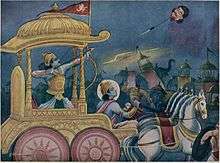
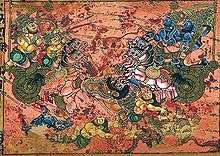
While searching for Jayadrath on the battlefield, Arjuna slew 7 akshauhinis (a battle formation that consisted of 153,090 chariots (Sanskrit Ratha); 153,090 elephants; 459,270 cavalries and 765450 infantry) of Kaurav soldiers. By Shakuni's plot, Duryodhana hid Jayadrath in their camp, since if Arjuna failed to kill Jayadrath he had vowed to throw himself into the fire, which would make war easier for the Kauravas. Lord Krishna fakes sunset using his Sudarshan Chakra and all the Kauravas insult and jeers at Arjuna, reminding him of his vow. Arjuna simply says to Krishna "it must have been your wish, Madhav" and starts walking towards the fire. Jayadratha, informed of the sunset by soldiers, starts towards Kurukshetra to kill Arjuna, but Shakuni soon learns of Krishna's plot and returns to Duryodhan. However Jayadrath returns to the battlefield where Shakuni reveals it's just Krishna's plot. Lord Krishna removes the chakra, removing the sunset environment. Jayadrath warns Arjuna if his head falls on the ground due to his bow he would be fired too, because of his boon by his father. Arjuna uses "Divyastra" to carry Jayadrath's head to his father leading to his own father's death. Many maharathis including Drona, Karna try to protect Jayadratha but fail to do so. Arjuna warns that everyone who supported adharma will be pathetically killed in this war.
While Arjuna destroyed the rest of the Shakatavuyha, Vikarna, the third eldest Kaurava, challenged Arjuna to an archery fight. Arjuna asked Bhima to kill Vikarna, but Bhima refused because Vikarna had defended the Pandavas during the Draupadi Vastrapaharanam. Bhima and Vikarna showered arrows at each other. Later Bhima threw his mace at Vikarna, killing him. The muscular Pandava was devastated and mourned his death saying he was a man of Dharma and it was a pity how he lived his life. Drona killed Vrihatkshatra, the ruler of Kekaya and Dhrishtakethu, the ruler of Chedi.
The battle continued past sunset. Dushasana's son, Durmashana, was slain by Prativindya, the eldest son of Draupadi and Yudhishthira, in a duel. When the bright moon rose, Ghatotkacha, the rakshasa son of Bhima, slaughtered numerous warriors, like Alambusha and Alayudha attacking while flying in the air. Karna stood against him and both fought fiercely until Karna released Vasava shakti, a divine weapon given to him by Indra. Ghatotkacha increased his size and fell dead on the Kaurav army killing an Akshauhini of them.
Day 15
After King Drupada and King Virata were slain by Drona, Bhima and Dhrishtadyumna fought him on the fifteenth day. Because Drona was very powerful and invincible, having the irresistible Brahmanda astra, Krishna hinted to Yudhishthira that Drona would give up his arms if his son Ashwatthama were dead. Bhima proceeded to kill an elephant named Ashwatthama and loudly proclaimed that Ashwatthama was dead. Drona approached Yudhishthira to seek the truth of his son's death. Yudhishthira proclaimed Ashwatthama Hatahath, Naro Va Kunjaro Va, implying Ashwatthama had died but he was not sure whether it was Drona's son or an elephant, The latter part of his proclamation (Naro va Kunjaro va) was drowned out by the sound of a conch blown by Krishna intentionally (a different version of the story is that Yudhishthira pronounced the last words so feebly that Drona could not hear the word elephant). Before this incident, the chariot of Yudhishthira proclaimed as Dharma Raja (King of Righteousness), hovered a few inches off the ground. After the event, the chariot landed on the ground as he lied.
Drona was disheartened and laid down his weapons. He was then killed by Dhrishtadyumna to avenge his father's death and satisfy his vow. Later, the Pandava's mother Kunti secretly met her abandoned son Karna and requested him to spare the Pandavas, as they were his younger brothers. Karna promised Kunti that he would spare them except for Arjuna, but also added that he would not fire the same weapon against Arjun twice.
Day 16
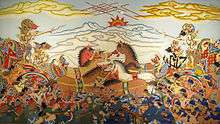
On the sixteenth day, Karna was made the supreme commander of the Kuru army. Karna fought valiantly but was surrounded and attacked by Pandava generals, who were unable to prevail upon him. Karna inflicted heavy damage on the Pandava army, which fled. Then Arjuna successfully resisted Karna's weapons with his own and also inflicted casualties upon the Kaurava army. Karna's son Banasena was killed by Bhima in front of Karna himself, and later, when Bhima and Karna fought, Karna was on the verge of death but was left alive by Bhima to help Arjuna fulfill his vow of killing Karna. On the same day, Bhima swung his mace and shattered Dushasana's chariot. Bhima seized Dushasana, ripped his right arm from his shoulder, and killed him, tearing open his chest, drinking his blood, and carrying some to smear on Draupadi's untied hair, thus fulfilling his vow made when Draupadi was humiliated. The sun soon set and with darkness and dust making the assessment of proceedings difficult, the Kaurava army retreated for the day.
Day 17
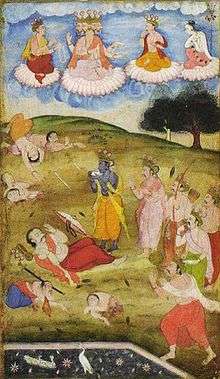
On 17th day, Bhima defeated Karna. Arjuna killed Susharma, Trigartas and Samsaptakas. Later Karna defeated the Pandava brothers Nakula, Sahadeva, and Yudhishthira in battle but spared their lives. Later, Karna resumed dueling with Arjuna. During their duel, Karna's chariot wheel got stuck in the mud and Karna asked for a pause. Krishna reminded Arjuna about Karna's ruthlessness onto Abhimanyu while he was similarly left without chariot and weapons. Hearing his son's fate, Arjuna shot his arrow which cut head of Karna. Karna's head fell on ground and a light ray from Karna's body got absorbed into Sun.
Day 18
On the 18th day, Shalya took over as the commander-in-chief of the remaining Kaurava forces. Yudhishthira killed king Shalya in spear combat and Sahadeva killed Shakuni. Nakula kills Shakuni’s son Uluka. Realizing that he had been defeated, Duryodhana fled the battlefield and took refuge in the lake, where the Pandavas caught up with him. Under the supervision of the now returned Balarama, a mace battle took place between Bhima and Duryodhana. Bhima broke the rules (under instructions from Krishna), and struck Duryodhana below the waist, leaving him mortally wounded.
Ashwatthama, Kripacharya, and Kritavarma gathered at Duryodhana's deathbed and promised to avenge the actions of Bhima. With Ashwatthama as general, they attacked the Pandavas' camp later that night and killed all the Pandavas' remaining army including their children. Amongst the dead; Dhrishtadyumna, Shikhandi, Uttamaujas, and children of Draupadi were killed by Ashwatthama. Other than the Pandavas and Krishna, Satyaki and Yuyutsu survived[31].
Aftermath
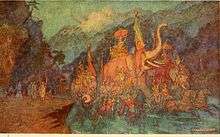
At the end of the 18th day, only twelve major warriors survived the war—the five Pandavas, Krishna, Satyaki, Ashwatthama, Kripacharya, Yuyutsu, Vrishaketu, and Kritvarma. Yudhishthira was crowned king of Hastinapur. After ruling for 36 years, he renounced the throne, passing the title on to Arjuna's grandson, Parikshit. He then left for the Himalayas with Draupadi and his brothers. Draupadi and four Pandavas—Bhima, Arjuna, Nakula and Sahadeva died during the journey. Yudhishthira, the lone survivor and being of pious heart, was invited by Dharma to enter the heavens as a mortal.
Notes
- Indian archeologist Swaraj Prakash Gupta and K.S. Ramachandran : "Divergence of views regarding the Mahabharata war is due to the absence of reliable history of the ancient period. This is also true of the historical period, where also there is no unanimity of opinion on innumerable issues. Dr Mirashi accepts that there has been interpolation in the Mahabharata and observes that, 'Originally it (Mahabharata) was a small poem of 8,800 verses and was known by the name Jaya (victory), then it swelled to 24,000 verses and became known as Bharata, and, finally, it reached the present stupendous size of the one lakh verses, passing under the name Mahabharata.'"[10]
- In discussing the dating question, historian A. L. Basham says: "According to the most popular later tradition the Mahabharata War took place in 3102 BCE, which in the light of all evidence, is quite impossible. More reasonable is another tradition, placing it in the 15th century BCE, but this is also several centuries too early in the light of our archaeological knowledge. Probably the war took place around the beginning of the 9th century BCE; such a date seems to fit well with the scanty archaeological remains of the period, and there is some evidence in the Brahmana literature itself to show that it cannot have been much earlier."[18] Basham cites H.C. Raychaudhuri, Political History of Ancient India, pp.27ff.
References
- Insoll, Timothy. Case Studies in Archaeology and World Religion: The Proceedings of the Cambridge Conference. Archaeopress. p. 166.
- Jaya: An Illustrated Retelling of the Mahabharata By Devdutt Pattanaik.ISBN 978-0143104254
- Murthy, S. S. N. (8 September 2016). "The Questionable Historicity of the Mahabharata". Electronic Journal of Vedic Studies. 10 (5): 1–15. doi:10.11588/ejvs.2003.5.782. ISSN 1084-7561. Retrieved 26 January 2019.
- Bronkhorst 2007.
- Samuel 2010.
- Singh, Upinder (2006). Delhi: Ancient History. Berghahn Books. p. 85.
- Singh 2009, p. 19.
- The Sauptikaparvan of the Mahabharata: The Massacre at Night. Oxford University Press. p. 13.
- Singh 2009, p. 18-21.
- Swaraj Prakash Gupta; K.S. Ramachandran. "Mahabharata: Myth and Reality". In Singh (ed.). Delhi: Ancient History. Social Science Press. p. 86. ISBN 978-8187358299. Retrieved 5 August 2016.
- Witzel 1995.
- Hiltebeitel 2005, p. 5594.
- Vedic Civilization by R.K. Pruthi. pg:-38 ISBN 978-8171418756
- Singh 2010, p. Chapter 7, Pp. 202-252, 302.
- "Experts dig up 950BC as epic war date". The Telegraph (Calcutta). 1 February 2015. Retrieved 1 October 2016.
- The Chronology of India: From Manu to Mahabharata ISBN 978-8194321309
- Basham 1954, p. 39-40.
- Basham 1954, p. 40.
- Parpola 2015, p. 299.
- Parpola 2015, p. 299-300.
- A.D. Pusalker, History and Culture of the Indian People, Vol I, Chapter XIV, p.273
- FE Pargiter, Ancient Indian Historical Tradition, p.180. He shows estimates of the average as 47, 50, 31 and 35 for various versions of the lists.
- Pargiter, op.cit. p.180-182
- B. B. Lal, Mahabharata and Archaeology in Gupta and Ramachandran (1976), p.57-58
- Keay, John (2000). India: A History. New York City: Grove Press. p. 42. ISBN 0-8021-3797-0.
- Sanu Kainiraka. From Indus to Independence - A Trek Through Indian History: Vol III The Disintegration of Empires, Volume 3. Vij Books India Pvt Ltd, 2016.
- C. Rajagopalachari, Mahābhārata, Bharatiya Vidya Bhavan. 1994 pp 183
- "The Mahabharata, Book 7: Drona Parva: Jayadratha-Vadha Parva: Section CXXXVIII". www.sacred-texts.com. Retrieved 7 July 2017.
- "The Mahabharata, Book 6: Bhishma Parva: Jamvu-khanda Nirmana Parva: Section I". www.sacred-texts.com. Retrieved 27 March 2018.
- "The Mahabharata, Book 7: Drona Parva: Abhimanyu-badha Parva: Section XLVII". sacred-texts.com. Retrieved 7 July 2017.
- Virodai, Yashodhara (31 August 2017). "कुरुक्षेत्र के एक भी योद्धा का देह नहीं मिला आज तक". Newstrend (in Hindi). Newstrend. Retrieved 13 August 2020.
Sources
- Basham, A. L. (1954), The Wonder that was India: A Survey of the Culture of the Indian Sub-Continent Before the Coming of the Muslims, ACLS Humanities E-Book, ISBN 978-1597405997
- Bronkhorst, Johannes (2017), "Brahmanism: Its place in ancient Indian society", Contributions to Indian Sociology 51, 3 (2017): 361-369
- Hiltebeitel, Alf (2005), "Mahabaratha", in Jones, Lindsay (ed.), MacMillan Encyclopedia of Religion, MacMillan
- Nilesh Nilkanth Oak, "When Did The Mahabharata War Happen?: The Mystery of Arundhati." Publisher: Danphe Inc
- Parpola, Asko (2015), The Roots of Hinduism. The Early Aryans and the Indus Civilization, Oxford University Press
- Samuel, Geoffrey (2010). The Origins of Yoga and Tantra. Indic Religions to the Thirteenth Century. Cambridge University Press.
- Singh, Upinder (2009), History of Ancient and Early Medieval India: From the Stone Age to the 12th Century, Longman, ISBN 978-8131716779
- Singh, Bal Ram (2010), Origin of Indian civilization (First ed.), Dartmouth: Center for Indic Studies, University of Massachusetts and D.K. Printworld, New Delhi, ISBN 978-8124605608, archived from the original on 4 March 2016
- Witzel, Michael (1995), "Early Sanskritization: Origin and Development of the Kuru state" (PDF), Electronic Journal of Vedic Studies, 1 (4): 1–26, archived from the original (PDF) on 11 June 2007

